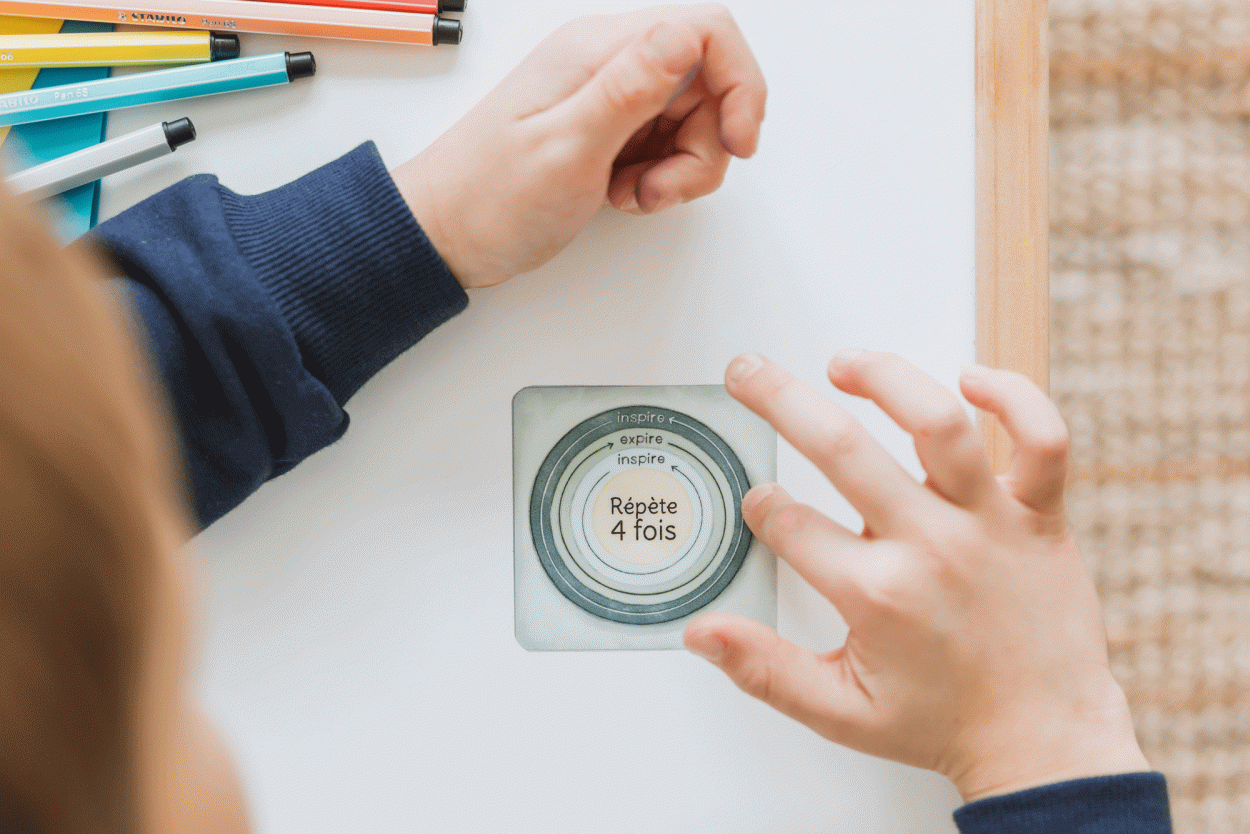Sensory strips, fidget strips, calm strips whatever you call them…these innovative tools have garnered attention for their potential to soothe restless energy and provide a discreet sensory outlet for kids with anxiety, ADHD, or autism symptoms.
In a nutshell, sensory strips are sensory stickers that come in various designs, colors, and surfaces. Each calm strip has a gentle texture meant to calm a child’s stress and help individuals with anxiety to remain focused.
The sale price of sensory strips makes them an accessible tool for most people. The design often focuses on hidden patterns that can blend into daily objects, like water bottles, notebooks, and desks. This allows kids to discreetly engage in a calm breathing exercise, manage their restless energy, or take a quick sensory break without drawing attention to themselves. These sensory stickers are indeed an effective anxiety mitigation solution.
While using sensory strips is still a relatively new practice, they are becoming integral to parents’ and teachers’ strategies for supporting children of all ages who have issues with anxiety.
Today, sensory strips can be found as fidget strips, calm strips, strips for anxiety, stickers for anxiety, and sensory stickers and adhesives for anxiety and stress. Let’s explore some of the most common questions about these sensory tools.
Understanding sensory strips
What are sensory strips?
Sensory strips are adhesive calm strips designed to provide a tactile experience that can help manage fidgeting, stress, social anxiety, ADHD, and autism. These sensory stickers, often featuring bright colors, have been specifically designed to satisfy the need to fidget.
The regular price of a calming sensory label depends on the quality of the material and whether or not it can be personalized with a child’s name. We recommend that parents choose customizable fidget strips so their kids quickly adopt finger-tracing actions on the stickers.
How do sensory strips work?
They work by engaging the sense of touch, offering a sensory input that can be calming and grounding. When a child runs their fingers over the textured surface, often with a brightly colored, fun design, it can create a focus point that distracts them from anxiety or overwhelming stimuli. Some sensory strips can even feature inspirational quotes as an added bonus to the sensory experience and means to keep a child more at ease.
What are the different textures of sensory strips?
Textures range from smooth and subtle to more pronounced ridges and bumps. The choice of texture is personal; some children may find a gentle ripple calming, while others may prefer a more distinct pattern.
What size are sensory strips?
Sensory strips are typically small enough to be discreet but large enough to be effective, usually a few inches in length and width.
Who created sensory strips?
The concept of fidget strips evolved from the need for sensory tools that could be easily integrated into daily life. Various companies and individuals have since refined and marketed these products. In fact, one maker of calm strip actually appeared on Shark Tank.
Sensory strips for specific needs
How do fidget strips work for anxiety?
By providing a physical texture to touch, discreet fidget tools can help redirect a child’s focus from anxious thoughts to the physical sensation, which can be particularly helpful for managing social anxiety or general anxiousness.
Do calm strips help with ADHD?
Yes, for those with ADHD, sensory strips with cute styles and assorted colors can be a conduit for excess energy, helping to increase focus and reduce restlessness.
Are calm stickers beneficial for autism?
Kids on the autism spectrum often benefit from sensory input to help manage their sensory processing. Sensory strips can provide a safe and controlled experience to help them remain calm.
What is the connection between sensory strips and stimming in ADHD and autism?
Stimming, or self-stimulatory behaviour, is a common way for children with ADHD and autism to manage sensory overload and express emotions. Some of the most common forms of stimming, such as bouncing, rocking, flapping hands, pacing, pulling hair, and repetitive skin rubbing and scratching, can be disruptive to other students at school or when kids are in public places. Textured stickers offer a discreet form of stimming.
Usage and application
Where do you put sensory strips?
They can be placed on any clean, flat surface, such as a desk, a laptop, or even the back of a phone. Many kids also like to have calm strips as water bottle stickers so that they can use them when they are on the go or at gym class.
How do you use sensory strips in the classroom?
Teachers can place sensory strips on students’ desks and notebooks to allow them to self-regulate without disrupting the class. It is important to encourage other students to be mindful and respectful of children who need fidget strips.
Here are some ways in which teachers can use anxiety relief strips in the classroom:
- Desk: Teachers stick anxiety calm strips to the surface of desks to allow students to fidget discreetly during lessons, helping them stay focused.
- Reading corners: Teachers place stress anxiety strips in reading or quiet areas to provide a calming activity while students are engaged in individual tasks.
- Transition times: Teachers can offer textured adhesives during transitions between activities to help students who may feel overwhelmed by the change in routine.
- Group workstations: Educators implement sensory adhesives at group tables to give students a shared tool for sensory regulation during collaborative work.
- Time-out zones: Teaching employees can provide calming strips in designated time-out areas where students can self-regulate before rejoining the class.
- Sensory paths: Educational staff can create a sensory path on the floor with textured stickers for students to walk on and experience various sensory feedback.
- Interactive whiteboards: Teachers can place rough sensory calm stickers around the borders of interactive whiteboards for students to use while thinking or waiting for their turn.
- Calm-down kits: These kits would include sensory strips, with both delicate patterns and rough patterns, in individual calm-down kits that students can use when they need a break or want a calm experience after dealing with an episode of sensory overload.
- Storytime: Teachers hand out portable sensory adhesive strips during story time or quiet reading to keep restless hands busy while still listening attentively.
- Reward system: Teachers and other educators could use fidget strips as a tactile reward for students who meet certain goals or exhibit positive behaviour.
Are fidget strips removable? How easy is it to remove them?
Most sensory strips are designed to be removable. Depending on the adhesive quality, they can usually be removed without leaving residue.
However, when you do shop for calm strips per pack, be sure to inquire about the durability. While you may want to remove a sensory strip occasionally, be sure to choose high-quality sensory stickers for anxiety and stimming so that they last a long time. Whether you choose delicate patterns or rough patterns, never skimp on calm strip durability. After all, these are products for anxiety relief!
What is the purpose of a sensory break, and how do calm strips fit in?
A sensory break is a short period of time when a child can engage in activities that help them regulate their sensory system. Fidget strips can be a tool used during these breaks to refocus and calm down.
Effectiveness and considerations
Do sensory stickers really work? What evidence supports their effectiveness?
While anecdotal evidence from users supports the benefits of stickers for anxiety, more empirical research is needed to establish their effectiveness formally.
How long do anxiety stickers last?
The lifespan of strips for anxiety varies based on the frequency of use and product quality. Typically, stickers for anxiety can last anywhere from a few weeks to several months and even years.
What are the benefits of using strips for anxiety?
Stickers for anxiety can serve as a subtle yet effective tool for managing stress, offering tactile stimulation that allows kids to divert their attention from distressing thoughts. When anxiety strikes, the act of touching or tracing the textures on these strips can create a focal point for the mind, steering it away from the cycle of worry and toward the present sensory experience.
Moreover, stickers for anxiety provide a non-disruptive outlet for nervous energy, which can be particularly useful in environments where overt coping mechanisms may be less appropriate, such as classrooms, gyms, and even playgrounds.
Engaging with a sensory strip requires minimal movement and attention, allowing individuals to remain involved in their current activities without drawing attention to their anxiety management process. Strips for anxiety ensure that the use of sensory strips doesn’t single out individuals or disrupt others, fostering a sense of security and self-sufficiency.
Are there any cons or considerations to keep in mind when using calm strips?
Some considerations include the potential for sensory strips to lose their texture over time and the need to ensure the strip’s texture and material are suitable for the user’s sensitivity level.
In conclusion, although the adoption of sensory strips is relatively recent, their growing integration into educational and home settings underscores their potential. They hold promise for providing not just a tactile diversion but a step towards fostering environments that are inclusive and supportive of diverse sensory needs. While empirical research is still catching up, the anecdotal success stories from parents, teachers, and children speak volumes about the positive impact these tools can have on those with sensory processing challenges.








